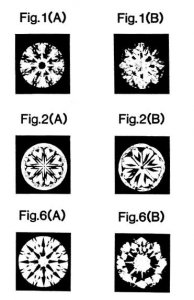- Joined
- Mar 28, 2001
- Messages
- 6,341
From Yamashita....
A photograph is attached to a written statement (see below illustration) of an expert opinion on a diamond. "This photograph is taken by a camera placed above the diamond while illuminating it from below. In the produced fringes, the brightest and least bright portions appear black to the naked eye, while the other portions appear whitish. This photograph has the following disadvantages.
(1) Those portions which should appear brightest are black like in a negative film of a black-and-white photograph.
Yamashita goes to explain that his invention will limit light entry into the diamond from 20° to 50° and that will tell the observer more about the diamond. “In any case, it is important that a gem of interest be placed inside the container such that light enters it from only the directions lying within the range of angles of 20 to 50 degrees about the line vertical to the gem. In other words, the fringes of interest can be clearly seen only if the gem is placed in the container satisfying these conditions and if the gem is observed or photographed while positively directing the light into the container.”
While this image is perhaps one of the first recorded of an actual Hearts image, again the focus appears to be centered around interpreting the meaning of the face up image. Not necessarily the preciseness of the pattern but the translation of the white and blacks. Of course later research discovered clearly what these were.
More....

A photograph is attached to a written statement (see below illustration) of an expert opinion on a diamond. "This photograph is taken by a camera placed above the diamond while illuminating it from below. In the produced fringes, the brightest and least bright portions appear black to the naked eye, while the other portions appear whitish. This photograph has the following disadvantages.
(1) Those portions which should appear brightest are black like in a negative film of a black-and-white photograph.
(2) Those portions which should be brightest and those portions which are least bright are equally black in the resulting image. Therefore, it is completely impossible to know which portions are really bright.
(3) The white portions in the photograph should have contain portions of varied degrees of brightness. However, these varied degrees of brightness produce little changes in the density in this photograph. Hence, almost no difference in brightness can be seen in the white portions. This also totally deprives the fringes of three-dimensionality.
In this way, this photograph is very difficult for laymen to understand though this situation may not apply to experts.
Yamashita goes to explain that his invention will limit light entry into the diamond from 20° to 50° and that will tell the observer more about the diamond. “In any case, it is important that a gem of interest be placed inside the container such that light enters it from only the directions lying within the range of angles of 20 to 50 degrees about the line vertical to the gem. In other words, the fringes of interest can be clearly seen only if the gem is placed in the container satisfying these conditions and if the gem is observed or photographed while positively directing the light into the container.”
While this image is perhaps one of the first recorded of an actual Hearts image, again the focus appears to be centered around interpreting the meaning of the face up image. Not necessarily the preciseness of the pattern but the translation of the white and blacks. Of course later research discovered clearly what these were.
More....











300x240.png)